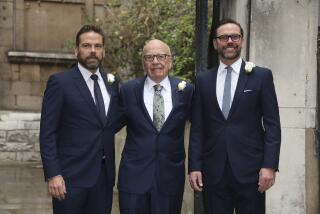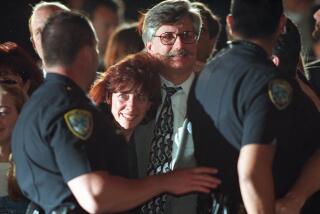4 Children Get Part of DHL Founder’s Estate
SAN FRANCISCO — Four children whose fabulously wealthy father allegedly picked their teenage mothers up in Pacific Rim honky-tonks will inherit as much as 60% of his estate--valued at $400 million to $600 million--under an agreement recently approved by a Saipan court.
A key part of the bitter international legal brawl over the fortune of Larry Lee Hillblom, founder of the DHL Corp. courier service, ended quietly in a Seattle laboratory, where genetic testing revealed that the children had the same father. The heirs range from 2 to 14 years of age and live in three nations.
Still to come are battles over the remainder of the estate--expected to be as much as $200 million. The state of California insists that much of the money should be spent on medical research here, based on a provision in Hillblom’s will that said his money should go to unspecified charities, with “substantially all” of it devoted to medical research with “particular attention” given to the University of California medical centers.
Saipan courts overseeing the estate battle, however, have indicated that at least some of the money should be spent on medical research in the South Pacific island where Hillblom made his home for many years.
The university system--which stood to receive the lion’s share of the estate before the unknown heirs surfaced--still hopes to receive most, if not all, of the remaining $200 million.
“It still will be bigger than anything ever bequeathed to the system,” UC regents’ attorney Eric K. Behrens said. “It’s huge.”
The fight over Hillblom’s far-flung fortune erupted shortly after the 52-year-old lifelong bachelor plunged to a watery death in his vintage World War II seaplane in May 1995. Hillblom’s body was never found, although pieces of wreckage and the bodies of his pilot and a friend who was flying with Hillblom that day were recovered.
Unresolved by the settlement between Hillblom’s estate and the four children are questions about the life, death and intentions of Hillblom, who friends say never seemed comfortable with the wealth he compulsively created and never acknowledged that he had fathered any children.
Buried in the reams of court documents generated by dozens of attorneys are poignant tales of teenage girls who say they were virgins when introduced to Hillblom in bars, then told by him to have abortions when their liaisons resulted in pregnancy. Through it all, the voices of the children who never knew the man they claim to be their father are never heard.
They are Junior Larry Hillbroom, 14, born to a Palauan mother who met Hillblom in a Palauan bar when she was 16. Junior now lives with his grandparents in Palau.
There is also Jellian Cuartero, 2, whose mother says she was 14 when a mama san, or madam, dropped her off in front of Hillblom’s condominium in the Philippines.
Mercedez Feliciano said she was 13 when she began living with Hillblom in his Manila condominium. Her daughter, 2-year-old Mercedita, was born seven months after Hillblom’s death.
Then there is 3-year-old Nguyen Be Lory, born to a Vietnamese teenager who said she was a waitress when she met Hillblom.
The legal fight has tarnished Hillblom’s memory, his friends say. They contend that the revelations about his personal life have diminished his accomplishments as a brilliant, self-made entrepreneur; that they cast a shadow over his charitable legacy and created a distorted image of Hillblom as a callous pursuer of innocent young women.
“At one point, there were lawyers going through bars in the Philippines, waving photographs around and asking if anyone had been with Larry,” Behrens said.
Hillblom’s two brothers, who are on the five-member board directing his charitable trust, are horrified by the spotlight the legal fight has trained on their brother’s private life, Behrens said.
In July 1995, attorneys representing Junior Larry Hillbroom filed a claim to the estate, saying he was Hillblom’s out-of-wedlock son by Kaelani Kinney.
Eventually, eight children--from Vietnam, Palau, Saipan, Guam and the Philippines--claimed that they were Hillblom’s offspring. Attorneys for some of the children, backed by the statements of mama sans who procured girls for bar patrons, said that Hillblom had sought out virgins, some as young as 14, on his business trips.
Four children have been shown through genetic testing to be siblings, said David Axelrod, attorney for Jellian Cuartero. Axelrod said it was genetic testing that spurred the settlement talks and formed the basis for the agreement between the directors of the Larry Hillblom trust and the children. A Saipan judge accepted the settlement in December.
“The circumstances of their conception, their mothers’ relationship with Hillblom and the fact that there is a 99.9% chance they are siblings were pretty persuasive to anyone that these were Hillblom’s kids,” Axelrod said.
“The fighting, hopefully, is behind us,” said Barry Israel, a Santa Barbara attorney for Junior Larry Hillbroom.
Israel, however, said that he intends to file lawsuits against directors of Hillblom’s trust in Saipan, alleging that they deliberately tried to keep the boy from inheriting his father’s fortune.
Israel, who said he fought Hillblom in several court battles starting in 1982, said he believes that the millionaire, himself a lawyer, would have enjoyed the turmoil his will has created.
“I don’t think this is a coincidence,” Israel said. “Larry liked to operate in a churning environment.”
Hillblom, born into modest circumstances in the Fresno County agricultural community of Kingsburg, co-founded DHL in 1969. In the late 1970s, the bespectacled bachelor retired from the company and moved to Saipan, the main island of the commonwealth of the Northern Mariana Islands. The Marianas are a U.S. possession and a tax haven for the wealthy.
In Saipan, Hillblom became a prominent public figure, once serving as a special judge to the Supreme Court. He lived modestly, wearing frayed jeans and cheap T-shirts, driving battered cars and buying rickety old planes that he loved to fly, although he didn’t have a pilot’s license. He had a brush with death in 1993, when a plane he was piloting crash-landed on the island of Tinian in the Marianas.
“Every bone in his face was fractured,” his friend and attorney Peter Donnici recalled in a 1996 interview with The Times. After that, Hillblom hired a pilot but refused to pay for a private jet, Donnici said. “Larry just wouldn’t spend the money.”
Although he rarely drank alcohol, Hillblom hung out with buddies in the island’s bars, followed its politics passionately and frequently filed lawsuits against the federal government on behalf of the Marianas. Cronies described him as a friendly, energetic man who never got around to fully furnishing the mansion he built on Saipan.
But there was another side to Hillblom, according to the affidavits filed in the legal battle. Hillblom traveled throughout Asia in the 1980s, buying real estate and making deals--and seeking entertainment and companionship in bars and strip joints.
Mama sans stated in affidavits that they introduced Hillblom to several virgins at his request. Hillblom reportedly insisted on engaging in unprotected sex with the bar girls.
*
After his death, the only will discovered was one written in 1982. The will said Hillblom’s estate should go to medical research, with special consideration to UC’s medical centers. There was no mention of any other charity. It made no mention of offspring but also did not contain standard legal language specifically disinheriting any children. That loophole was pounced on by attorneys who quickly descended upon the estate in Saipan, and in Vietnam and the Philippines, where Hillblom had holdings.
Initially, representatives of Hillblom’s trust denied that he had fathered any children. Even if he had, Donnici said in 1996, “he wanted this money to go to charity.”
Anxiously watching the proceedings from the start has been the UC regents and the California attorney general’s office, where attorneys initially said they believed that the terms of Hillblom’s will meant that most of his estate should go to medical research in California. But the attorneys worried that if one or more child proved that Hillblom was the father, the entire estate might go to the offspring.
“It was always risky litigation,” said attorney Peter Shack, who followed the case for Atty. Gen. Dan Lungren.
Last summer, lawyers for four of the children laying claims to the estate arranged for their blood to be tested. The tests paved the way for the settlement, Axelrod said. The other four children--three born to one mother--have entered into separate settlements with the estate for an undisclosed amount that is believed to be much smaller. Lawyers following the case said genetic testing revealed that they did not share the same father.
Under the terms of the settlement, blood samples from the four children who tested as siblings are to be tested again this month. If the results reconfirm that they share a father, they will begin receiving support payments of $5,000 apiece each month from the estate until Hillblom’s assets are liquidated.
In addition, Israel said, Junior Larry will inherit the shares his father owned in the Bank of Saipan.
“He will be a major shareholder and that’s a wonderful legacy,” Israel said. “But more importantly, he will know who his father was. For the last three years, he has had to listen to people say that Larry wasn’t his father.”
More to Read
Inside the business of entertainment
The Wide Shot brings you news, analysis and insights on everything from streaming wars to production — and what it all means for the future.
You may occasionally receive promotional content from the Los Angeles Times.










